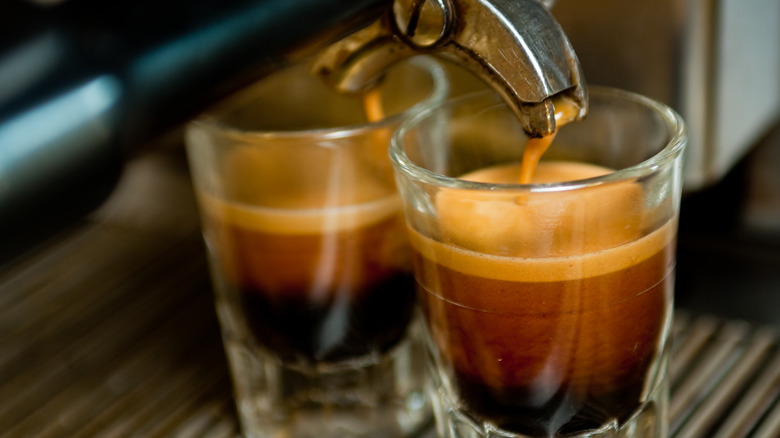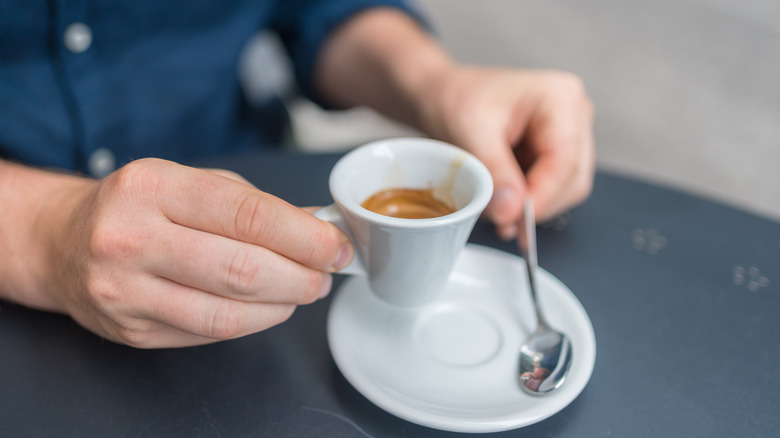Why Crema On Your Espresso Isn't Always A Good Thing
A perfectly pulled shot of espresso can be a thing of beauty. Most espresso lovers will agree that the exquisitely small steaming cup of dark, velvety liquid offers a more intense coffee-drinking experience than any other cup of joe. The first visual sign that your espresso is good is the layer of caramel-colored foam or crema that rests atop your coffee.
How would you react if you've ordered an espresso and it arrives without its essential layer of crema? There's a school of espresso drinkers who would be appalled if they got a "flat" black espresso with no crema, and with good reason. The layer of crema is a sign of high-quality roast and grind of the coffee, as well as a skilled barista using good coffee-making equipment. But for some, the crema's bitterness may subdue the fruity and acidic notes of the coffee. Too much crema can overwhelm most of the subtle flavors in your coffee. However, this might not be a bad thing for dark-roast lovers, especially those who enjoy the full-bodied mouthfeel and bitter "kick" of an espresso shot. Ultimately, depending on your preference, you can either scrape off the crema or stir it into your cup. Each strategy will result in a distinct flavor profile for your espresso.
What exactly is coffee crema? When is it good, and when is it not?
The high-pressure extraction method synonymous with modern espresso and also responsible for crema formation was first introduced by Achille Gaggia in the 1930s while working at his family's coffee bar in Milan. The coffee crema that floats atop an espresso is a homogenized mixture of natural oils from the coffee beans, and the water passed through the coffee at high pressure. The frothy nature of the crema is due to carbon dioxide released when coffee beans are roasted, which is also why darker roasts result in more crema.
In addition to the rich caramel-colored aesthetic and signs of a good espresso, the crema also has a few practical purposes. The fluffy matrix of oil, water, and carbon dioxide forms a lid over your coffee, which helps retain heat and aroma for longer. The downside is that the first few sips of velvety smooth espresso will pass through the bitter, slightly ashy layer of crema. Eventually, as with any beverage with an effervescent head, the foam will disappear. But, until then, it will be the foremost tasting note of every sip.
Though crema can be pretty unpleasant when tasted in isolation, it can also elevate the flavor complexity. After all, it contains natural oils from the coffee bean and will, therefore, add more taste and aroma notes to the beverage. That said, there's no escaping the fact that it can overwhelm subtle flavors. Ultimately, the only way to figure out how you like your espresso (avec or sans crema) is by trying both versions side by side.
How you remove crema affects your coffee experience
An espresso should be good enough to have crema. Ironically, to enjoy the potent little cuppa best, you must diminish that crema. You can scrape it off by skimming the top with a spoon or stir it into your coffee. The latter technically doesn't remove the crema, and a thin layer will still remain, however, it will mitigate how much of it precedes every sip.
Stirring the crema can make the overall texture of your coffee more luxurious, resulting in a richer mouthfeel and a more prolonged aftertaste since the thickened concoction will coat the insides of your mouth better. This technique also works well for those who like to add a sweetener to their espresso, which helps balance the crema's smokey bitterness. The result is a balance of strong bittersweet notes reminiscent of dark chocolate, caramel, and roasted nuts.
Conversely, scraping the crema brings out the acidic, fruity, and sweet palate of the beverage without the lingering aftertaste. Since espresso is generally made with dark roasts, you'll still get the bitter, dark, and smokey notes, albeit less pronounced. This method opens up the entire cross-section of flavors, letting you sip your coffee like wine. The milder, more nuanced character also makes a scraped espresso great for having without the addition of any sweetener.
Finally, a note on bean selection. Espresso made from 100% arabica coffee beans will tend to have more acidic, fruity, and floral notes, making it an ideal cup to explore after scraping off the crema. If you're drinking a robusta and arabica blend, you can stir or scrape, depending on the espresso experience you're in the mood for.


